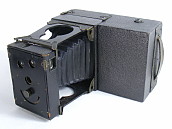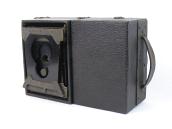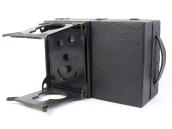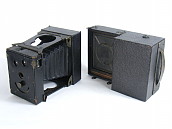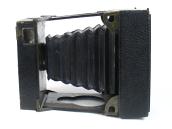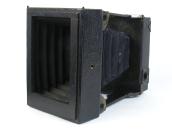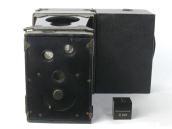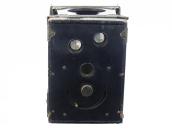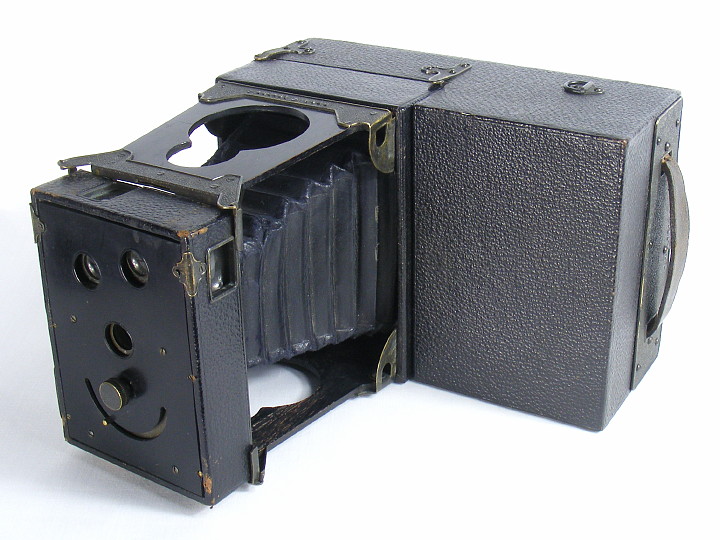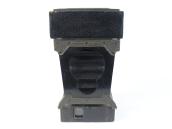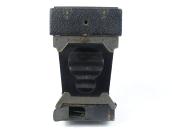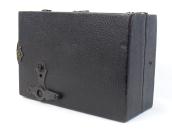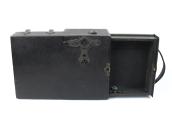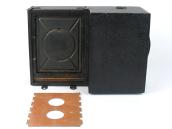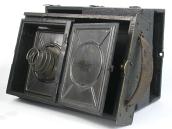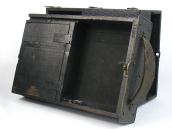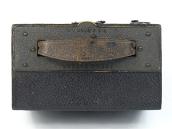Folding Frena Camera
R. J. Beck Ltd
| Name: | Folding Frena |
| Manufacturer: | R. J. Beck Ltd |
| Country of Origin: | United Kingdom |
| Construction: | Leather covered wooden body, with metal struts to support the lens / shutter panel, with leather bellows, the camera then integrating with the Frena film magazine back. |
| Production Period: | 1900 - ? |
| Model / Variant: | No 6 |
| Plate / Film Size: | 3¼" x 4¼" Frena film |
| Lens: | Beck Single Achromat f11 |
| Shutter: | Sector type, spring powered. The sector size is adjusted to vary the exposure |
| Movements: | None |
| Dimensions (h x l x d): | 14.5 x 21 x 8.5 cm (closed); 14.5 x 11 x 18 cm (camera only, open) |
| Date of this Example: | c1901 |
| Serial Number: | Serial 16320 stamped into edge of drawer and also repeated on changer handle |
| Availability: |
|
| Inventory Number: | 631 |
|
Photos copyright © 2016 David Purcell. Do not use without permission. |
Description
The Folding Frena No 6 camera has open side metal struts to support the lens standard that holds the shutter, lens and viewfinders. The other three models of the Folding Frena (No 7, No 8, and No 8a) had a more conventional folding bed format. With all four models, the folding camera body is coupled with a Frena film magazine back (see below), although the camera unit could be used in isolation if one or more optional dark slides were purchased.
The camera body is of wooden construction, with black leather covering and black leather tapered bellows. The camera clips to the film magazine by sprung catches on the top edge, and is held by retaining clips on the lower edge. When the two units are clipped together and the camera is closed up for transport (Photo 1), the camera unit itself occupies approximately one quarter of the whole. The remainder is the film magazine, which effectively consists of three distinct elements: a receiving chamber for the exposed film, a chamber holding the unexposed films (up to 40 sheaths at a time) and finally the changing mechanism, the drawer unit forming a key part of these last two elements that form the changing box.
To operate the changing box the camera must be held with the receiving chamber horizontal and below the changing box. In this position a gravity catch is released that otherwise prevents the changing box draw from being opened. (The weighted catch can be seen in photos 11 and 21 above). Once the draw of the changing box is pulled out, a plate on the inside of the box engages with a slot in the changing mechanism. The plate can be turned by a handle on the outside of the camera (photo 2) which moves the pins of the release mechanism.
The draw has to be removed completely to load / unload the film. To do so, the button above the film counter must be pulled out to release the drawer. With the drawer removed, the film chamber can be accessed by opening the door cover that is then accessible.
Notes
The Folding Frena cameras are scarce and far less common than the earlier box form Frena.
The folding Frena cameras were not produced for very long, and are not believed to have proved popular, likely accounting for their scarcity. They are cumbersome and awkward to use and once attached to the film magazine, are quite large and heavy to carry.
![[ ]](../../images/unchecked.png)
![[x]](../../images/checked.png)
